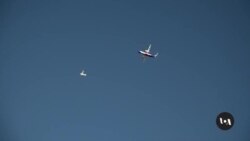Hydrogen-powered airplanes leave a trail of water vapor in the sky instead of harmful fumes.
Welcome to VOA Asia Weekly. I'm Chris Casquejo in Washington. That story is coming up, but first, making headlines:
Chinese President Xi Jinping left Hanoi on Wednesday after a two-day state visit to Vietnam. He was there to shore up Beijing's relationship with the southeast Asian nation. The Communist-ruled neighbors, close in economic areas but at odds over boundaries in the South China Sea, signed dozens of co-operation pacts and agreed to set up more hotlines to defuse any emergencies in the contested waters.
Indonesia's three presidential hopefuls faced off in the country's first election debate on Tuesday, with two candidates slamming a court decision that enabled the president's eldest son to join the leading ticket. A recent court ruling changed the age requirements for candidates. This effectively paved the way for President Joko Widodo's 36-year-old son to be named the vice-presidential candidate of defense minister, Prabowo Subianto. The ruling sparked fears about backsliding democracy and a return to the nepotism and patronage politics that characterized the decades-long rule of former president Suharto. He was forced from power in 1998.
Indonesia's Marapi volcano erupted on Wednesday, spewing volcanic ash as high as 500 to 600 meters into the air, according to the country's volcanology agency. The latest activity comes a week after an eruption on Marapi killed 23 people.
Beijing authorities shut schools and told people to stay home on Wednesday as a mass of cold air drifted into the Chinese capital from the west, the second cold wave this week.
Business confidence at big Japanese manufacturers improved in the three months to December for a third quarter in a row, a closely watched central bank survey showed on Wednesday. This underscores the strength of the country's economic recovery.
State-owned Chinese aerospace company COMAC showcased its domestically developed C919 passenger jet in Hong Kong, giving officials and media a close look at the narrow-bodied aircraft. A welcome ceremony for the C919 and an ARJ21, another Chinese-made jet, was held at the Hong Kong international airport. COMAC is preparing to take on Airbus and Boeing in the market for single-aisle commercial aircraft, but some components, like the engine, are still sourced in the West.
A California company is converting jet-fuel aircraft to run on hydrogen to reduce emissions that harm the environment. VOA’s Genia Dulot looks at these experimental planes that are already in the air.
Test pilot Alex Kroll is ready for takeoff at the Mojave Air and Space Port.
“Mobi tower, Lighting One ready for hydrogen powertrain start.”
California-based Universal Hydrogen is converting jet-fuel aircraft to run on hydrogen. Company president Mark Cousin says that will cut carbon emissions in aviation as hydrogen produces just heat and water.
“And that water just comes out through an exhaust here, and it just comes out behind the aircraft as water vapor, so we leave a trail of water behind rather than a trail of CO2 and nitrous oxide and soot and everything else that comes out of the back of a gas turbine.”
Instead of burning hydrogen in a gas turbine like jet fuel, this technology reacts hydrogen with air in a fuel cell to drive an electric motor. Removing plane seats to make room for the hydrogen cells reduces the number of passengers it can carry, and the electric powertrain is heavier than the gas turbine it replaces. But engineer Loris Gilner says that is offset by hydrogen’s greater efficiency.
“For this size of aircraft, we think that this way is better because the hydrogen fuel cell powertrain is about twice as efficient as the Pratt & Whitney turboprop. It means we can travel twice as far for the same quantity of hydrogen.”
The flight is also much quieter. Without a turbine, the only noise comes from the spinning propellers. The company is working toward having hydrogen aircraft in commercial service by 2026, flying routes up to three hours long.
Genia Dulot, VOA News, Mojave, California.
Visit voanews.com for the most up-to-date stories.
I’m Chris Casquejo.
We leave you now in the Chinese capital of Beijing, where a giant panda in the zoo enjoyed the season’s first snowfall on Monday.
Thanks for watching VOA Asia Weekly.












